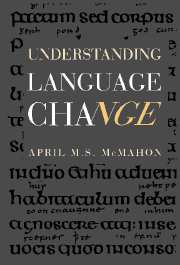Book contents
- Frontmatter
- Contents
- Preface and acknowledgements
- 1 Introduction
- 2 Three views of sound change
- 3 Sound change 2: the implementation problem
- 4 Morphological change
- 5 Syntactic change 1: the Transparency Principle
- 6 Word order change and grammaticalisation: language change and general laws
- 7 Semantic and lexical change
- 8 Language contact
- 9 Linguistic variation
- 10 Pidgins and Creoles
- 11 Language death
- 12 Linguistic evolution?
- Bibliography
- Index
5 - Syntactic change 1: the Transparency Principle
Published online by Cambridge University Press: 05 June 2012
- Frontmatter
- Contents
- Preface and acknowledgements
- 1 Introduction
- 2 Three views of sound change
- 3 Sound change 2: the implementation problem
- 4 Morphological change
- 5 Syntactic change 1: the Transparency Principle
- 6 Word order change and grammaticalisation: language change and general laws
- 7 Semantic and lexical change
- 8 Language contact
- 9 Linguistic variation
- 10 Pidgins and Creoles
- 11 Language death
- 12 Linguistic evolution?
- Bibliography
- Index
Summary
Introduction
Diachronic syntax lay, like the Sleeping Beauty, in a deathlike coma for the first half of this century. In the late sixties and seventies there was a flurry of activity as increasingly large numbers of linguists realised the importance of the subject, and attempted to hack their way through the thorns encircling the Sleeping Beauty's castle and into the central issues of the topic … [David Lightfoot's] is the first book which has attempted both to provide a fully-fledged theory of syntactic change, and to clarify the relationship between a theory of change and a theory of grammar. As such, [his] work is of great significance, since he may be viewed as the Prince who woke the Sleeping Beauty from her long sleep. Nevertheless, although he has woken her, he is not necessarily the answer to all her prayers. As with many pioneers, his work is perhaps more important for the questions it raises than for the solutions it provides.
(Aitchison 1980: 137)This rather long and romanticised quotation is from a review of Lightfoot's book Principles of Diachronic Syntax (1979a), and outlines the direction we shall take in this chapter. We shall begin by considering earlier work on syntactic change, but will focus on Lightfoot's contribution. One of his case studies, and his general theory, will be outlined in 5.3, while 5.4 reviews some reactions and criticisms provoked by his ideas, and 5.5 introduces aspects of his more recent work (Lightfoot 1988, 1991).
- Type
- Chapter
- Information
- Understanding Language Change , pp. 107 - 137Publisher: Cambridge University PressPrint publication year: 1994



